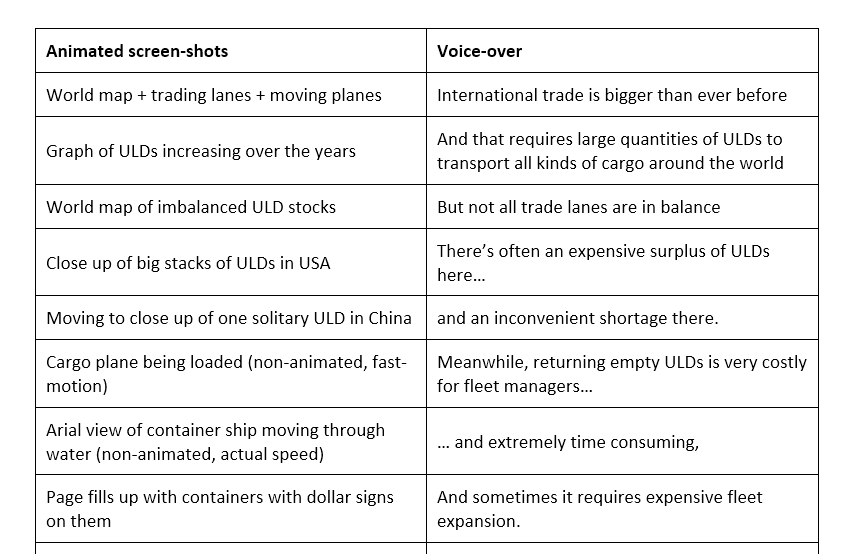10 Hot Tips for Writing Winning Video Scripts (Part 2)
By Helen McCrone, Certified SEO Copywriter | Word Count 1,271
Writing a script for a marketing video can be challenging. They're short in length compared to the average blog post. But scripts involve numerous steps and – in many cases – a degree of collaboration.
In my previous article ‘Hot Tips for Writing Video Scripts That Outshine Your Competitors (Part 1)’, I explained how to tackle the planning stage of script writing by outlining eight important steps to take before you pick up your pen or tap away on your keyboard.
In this article, I’m going to give you ten handy tips for the actual writing stage. Read on!

1. Keep sentences short and simple
Long, complicated sentences can distract viewers. Remember that they’ll be processing the visuals at the same time as listening to the script, so don’t overwhelm them. Use unfussy sentence structures and insert plenty of breathing spaces (natural pauses) to give the viewer time to absorb the message.
(Tip: Use the Read Aloud feature in Word to hear your script. The voice is a bit mechanical, but it does highlight clumsy and lengthy sentences.)
2. Use the pronoun ‘you’ throughout
You want the viewer to feel that this is a one-to-one conversation even though it’s not, and the best way to do that is to do that is to use the personal pronoun ‘you’. To illustrate, decide which of the two sentences below sounds more intimate:
Sentence 1
People who think they need fancy equipment and expensive software to make great videos need a new approach to their video marketing strategy.
Sentence 2
Think you need fancy equipment and expensive software to make great videos? Then you need a new approach to your video marketing strategy.
(Hint: It’s not the first sentence)
3. Adopt the right tone
You need to find a tone of voice that suits the role of the actor or narrator and best connects with your target audience. To do that, you need to know what your brand personality is. Is it cutting edge or established, friendly or corporate, spontaneous or thoughtful?
Knowing the defining characteristics of your brand helps you find the right approach. To bring the point home, compare these guarantee messages from two online pet supply companies:
BarkBox
Our Pack Has Your Back! If your dog isn't 100% happy with their BarkBox, we’ll work with you to make it right. No muss, no fuss, no disappointed pups.
Chewy
Our experts are here 24/7 to answer questions and help you find the perfect items for your pet. We also have a 100% Unconditional Satisfaction Guaranteed Policy on every order, just in case they’re not crazy about that new food or toy. Shopping for your pet has never been easier.
As you can see, they’re basically the same message, but delivered in two very distinct styles.
4. Respect rhythm and tempo
It’s important that the actor or narrator holds the viewer’s attention for the length of the video and enhances the overall listening experience. Their skill at presenting or narrating is a key factor here, but if the script doesn’t flow, they’ll be hamstrung.
Creating rhythm in a script can be tricky to master, especially if writing is not your day job, but here are a few tips:
5. Write as you speak
Another way to aid the actor or narrator in delivering your script is to write the way you speak. For example, instead of writing:
“and that is why we will donate 100% of our sales on July 4”,
write this:
“and that’s why we’ll donate one hundred percent of our sales on the Fourth of July.”
The differences are subtle, but this technique will really help the performers to speak naturally and fluently. Their brains won’t have to translate the written word into the spoken word. They simply read aloud what is in front of them.
6. Incorporate verbal directions
Sometimes you need to tell the audience what to look at in the visuals. You do this with phrases such as “In this graph here, you can see…” or “You can set this up just like Jesse is doing here”.
By guiding the audience in this way, they won’t lose track of what is being said.
7. Incorporate verbal signposts
Alert your audience whenever you’re about to reiterate a point, move on to a new point, or even go back to a previous point.
Do this by using signposts. In an explainer video, for example, you need phrases like “Now let’s think about...”, “Okay, so you’re done planning, now it’s time to…” and “Lastly, always make sure…”.
The technique of signaling a transition is used all the time in presentations, and it’s really useful in videos too. It allows your audience to hold their attention so the video can deliver its marketing message effectively.

Signposts help us to not get lost at important moments
8. Mark the script for the actor or narrator
As the author of the script, you’ll know which words you want emphasized for dramatic effect. But it might not be so obvious to the actor or narrator. So, help them out by marking the script.
Marking includes underlining words to stress and inserting / or // in places where you want them to pause. Use one slash for a micro-pause and two for a breath. This technique tells the actor or narrator which words carry extra meaning or emotion and are important to your overall message.
Here’s an example from a script I wrote for a chiropractor:
We start by diagnosing the cause of your pain. Then we reduce your pain levels. The Pain Relief Centre has a full range of therapies, from ultrasound and chiropractic manipulations / to spinal decompression therapy and Electric Muscle Stimulation.
//
Now, those may sound a little scary, but I promise you / they’re non-violent, unobtrusive, and completely safe. What’s more, all chiropractors who work here—myself included—are licensed and have had years of experience.
How much you underline is up to you. If the actor or narrator is a professional, they’re not going to need too much guidance, so restrict yourself to only those words that are really important or where the emphasis is not obvious.
9. Include call outs to the video producer
If you read my previous article on script-writing, you’ll know that it’s a good idea to use a two-column layout. In the right-hand column, write your script (what the audience hears). Use the left-hand column for instructions, comments, and screen shot descriptions (what the audience sees).
For example, you could write ‘long shot of actor walking through the office’ or ‘close up of engineer working on machine’. This will help the video maker enormously in matching the visuals with the script.

You can watch the completed marketing video of the script above.
10. Identify who is saying which lines
If you have more than one speaker or actor, you need to identify who is saying what to avoid confusion. Therefore, assign names or roles to every block of speech.
So, there you have it. Ten tips to help you write a winning script for your marketing videos. If you have any of your own to share, let me know in the comments below. You can also check out my video script writing service.

